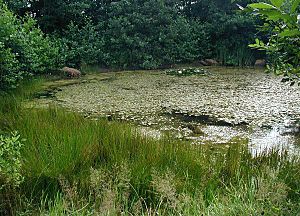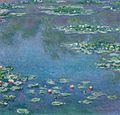Pond facts for kids
A pond is a body of water that is usually smaller than a lake. Ponds are often shallow enough for sunlight to reach the bottom. This means that plants can grow all the way across the pond floor. Ponds are amazing homes for lots of different animals! You might see ducks, turtles, swans, small fish, and frogs living there.
Some ponds don't last all year round. These special ponds are called vernal ponds, or sometimes ephemeral, seasonal, or temporary wetlands. They fill up with water during rainy seasons or when snow melts, but then they dry up later in the year. Because they dry up, these types of ponds usually don't have any fish. Sadly, some ponds are getting polluted because of human activities, which can harm the plants and animals that live there.
Contents
What is a Pond?
A pond is a natural or artificial area filled with water. It's smaller than a lake but bigger than a puddle. Ponds can be formed in many ways, like from rainwater collecting in a dip in the land, or even by people digging them for different purposes.
How Ponds are Formed
Ponds can be created naturally when water collects in low areas of the land. This can happen from rain, melting snow, or even groundwater seeping up from below the ground. Some ponds are also made by humans. People might dig ponds for farming, to help control floods, for decoration in parks, or to create habitats for wildlife.
Pond vs. Lake
The main difference between a pond and a lake is usually their size and depth. Lakes are much larger and deeper than ponds. In a lake, sunlight often can't reach the very bottom in the middle, but in most ponds, it can. This difference in depth affects what kinds of plants and animals can live in each.
Life in a Pond
Ponds are bustling with life! They are important habitats for many different creatures, from tiny insects to larger animals.
Animals in Ponds
You can find a wide variety of animals living in and around ponds:
- Insects: Dragonflies, damselflies, water striders, and mosquito larvae all call ponds home.
- Amphibians: Frogs, toads, and salamanders lay their eggs in ponds and spend part of their lives there.
- Fish: Small fish like bluegill, sunfish, and catfish often live in permanent ponds.
- Reptiles: Turtles and some types of snakes can be found swimming or basking near ponds.
- Birds: Ducks, swans, herons, and other water birds visit ponds to find food and shelter.
- Mammals: Animals like otters, beavers, and raccoons might also visit ponds to hunt or drink water.
Plants in Ponds
Ponds are also home to many different types of plants. These plants provide food and shelter for the animals.
- Submerged plants: These plants grow completely underwater, like pondweed.
- Floating plants: Plants like water lilies and duckweed have leaves that float on the surface.
- Emergent plants: These plants grow in the shallow edges of the pond, with their roots in the water and their stems and leaves sticking out, like cattails and reeds.
Types of Ponds
Not all ponds are the same! There are different types depending on how they are formed and how long they last.
Vernal Ponds
Vernal ponds are special because they are temporary. They fill up with water in the spring or after heavy rains, but then they dry up completely during the summer or fall. Because they dry up, fish usually cannot live in vernal ponds. This makes them very important for amphibians like frogs and salamanders, as their eggs and tadpoles are safe from fish that might eat them.
Artificial Ponds
Many ponds are created by people. These are called artificial ponds. They can be built for many reasons:
- Garden ponds: Small ponds in backyards for decoration or to keep ornamental fish like koi.
- Farm ponds: Used by farmers for watering crops or livestock.
- Retention ponds: Built to collect and hold stormwater runoff, helping to prevent floods.
- Fishing ponds: Stocked with fish for recreational fishing.
Pond Health and Pollution
Ponds are delicate ecosystems, and they can be affected by pollution. When harmful substances get into a pond, they can hurt the plants and animals living there.
Sources of Pollution
Pollution can come from different places:
- Runoff: Rainwater can wash chemicals from farms (like fertilizers and pesticides) or oil and trash from roads into ponds.
- Litter: People sometimes throw trash into or near ponds, which can harm wildlife.
- Waste: Untreated sewage or industrial waste can also pollute ponds, making the water unsafe.
Protecting Ponds
It's important to protect ponds to keep them healthy. We can help by:
- Not throwing trash into ponds or nearby areas.
- Being careful with chemicals around water sources.
- Supporting efforts to clean up polluted areas.
- Learning more about pond ecosystems and sharing that knowledge with others.
Images for kids
-
Pond at Cornjum, Netherlands
-
Vegetated pond within the sand dunes of the Lençóis Maranhenses National Park, Brazil
-
The Pond in Central Park in Manhattan, New York City
-
Ornamental pond with waterfall in Niagara Falls Rock Garden
-
A small agricultural retention pond in Swarzynice, Poland
-
Siddha Pokhari, a reservoir pond in Bhaktapur, Nepal
-
During the last thirty years of his life, the main focus of Claude Monet's artistic production was a series of about 250 oil paintings depicting the lily pond in his flower garden.
See also
 In Spanish: Estanque para niños
In Spanish: Estanque para niños















